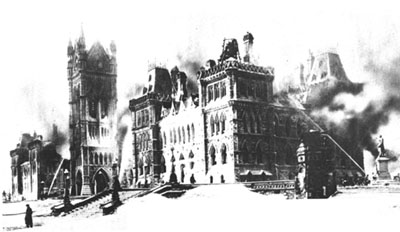On the dull, cool evening of February 3, 1916 there was barely a quorum of members in Ottawa's House of Commons. The honourable member for Northumberland, W.S. Loggie, was droning on about the question of improving the transportation of fish. Suddenly there was a commotion at the main door of the chamber. Two men rushed in and one shouted "Fire... Everybody get out!"
Members of the press gallery who took their time going down the winding staircase were quickly immersed in thick black smoke. Along the way they ran into the prime minister, Sir Robert Borden, and his secretary making their way to the exit almost on hands and knees. Members who dallied getting out of the chamber found themselves trapped in the dark when the lights went out. George Elliot, the MP for North Middlesex, called to the others to join hands and led them to safety. In a short time the entire centre block was an inferno.
From time to time Canadians, exasperated with their government, may fantasize about burning down Parliament. In fact, they did it once, in Montreal in 1849, setting fire to the legislature and preventing the firemen from dousing it. That fire and the riots surrounding it had led to the great controversy over the safest place to locate the Canadian Parliament. Queen Victoria was asked to intervene and she chose Ottawa. The original Parliament Buildings were built in the neo-Gothic style from 1859 to 1867. In their variety of form, gusto of detail and grand scale, they made a monumental impression unrivalled even in England. For a mere colony, they were a marvel.

|
| Parliament still smouldering the day after, Febraury 4, 1916 (courtesy NAC). |
The fire of 1916 started in the reading room, where members were known to smoke despite the prohibition. Once the fire started it greedily consumed stacks of loose paper. The room was soon a mass of blazing lumber. Muffled explosions accompanied the collapse of sections of roof, sending millions of sparks into the starry sky. By 10 p.m. the building was doomed. The huge tower filled with smoke. The big clock gamely struck 10 and 11 as the flames climbed higher, but before it could strike 12 the massive bell crashed into the rubble. At 1:21 a.m. the tower crumbled and collapsed into a mass of smouldering masonry.
The most heroic firefighting took place to save the priceless library. Aided for once by a breeze that swept the fire away, the firemen and soldiers succeeded in keeping the library intact.
MPs and workers alike fled by jumping, crawling, staggering, and scrambling down make-shift ladders. Thomas MacNutt and Dr Cash, MPs from Saskatchewan, were both in the lavatory when warned of the fire. When the door was barred by a wall of flame, they were forced to escape through a window. They fashioned a rope by tying towels together. Cash went first and dropped 20 feet from the end of his towel rope. MacNutt and a janitor managed to lower a ladder. Minister of finance, Sir Thomas White escaped through the Senate.
When the speaker of the House Albert Sévigny discovered the fire, he raced from his office and gathered up his two children and his wife. Mme Sévigny had been entertaining three lady guests. Two of them, Florence Bray and Mable Morin, insisted on going back for their furs and were suffocated. The third woman escaped by hanging for ten minutes from a window before dropping 40 feet below into a firemen's net. Five others died in the fire: a policeman, 3 government employees and an MP, Bowman Brown Law, from Yarmouth, NS.
Canadians were appalled by the destruction of their House of Parliament. The country was at war, and it was inevitable that suspicions of a terrorist plot hatched by "the Hun" would flare as wildly as the flames. Newspapers speculated that a gang of spies had brought "some infernal contrivance" into the building and set off "an explosion to so chemically charge the atmosphere that in the twinkling of an eye it burst into flames."
Locals with German-sounding names were questioned by police. The local fire chief insisted that the fire had been "set and well set." When asked, witnesses remembered seeing "suspicious looking foreigners." One Charles Sloney "who claimed to be born in Belgium" was arrested in Windsor, Ontario, and accused of being part of a gang who had set the fire. He spoke "with a decided foreign accent," reported the Ottawa Citizen, and his Belgian passport was presumed to be "a clever forgery." The only evidence against him turned out to be a postcard of the Parliament he was carrying and he was released.
A Royal Commission was convened to investigate the fire. It found no evidence of a conspiracy but laid much blame on those who smoked cigars in the reading room where so much combustible material was kept. The commission concluded that the system of ventilation, combined with extensive varnishing and use of shellac, the driest pine, together with loose newspapers "was the most perfect arrangement ever devised for a sudden and successful conflagration."
Prime Minister Borden predicted "even a grander pile will rise, Phoenix-like from the ashes." The new Parliament Buildings opened in 1917, less fanciful than the last, but more fireproof.

 Share on Facebook
Share on Facebook Share on X
Share on X Share by Email
Share by Email Share on Google Classroom
Share on Google Classroom


